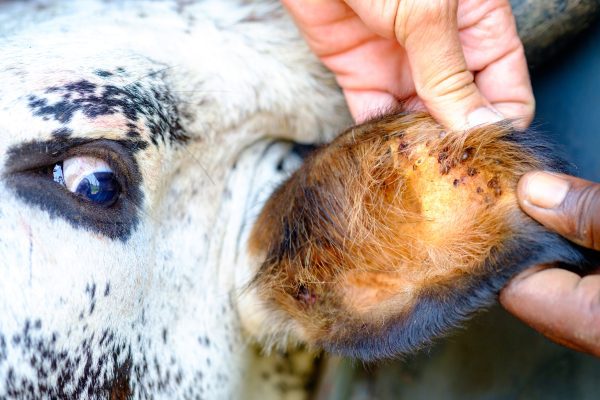
Mange in Cattle! If you’ve ever noticed your cattle scratching incessantly, losing hair, or developing crusty skin, you might be dealing with the dreaded scourge of mange in cattle. Mange is caused by microscopic parasites called mites, burrowing into or living on the skin, wreaking havoc on your herd’s health and your bottom line. But don’t panic! With a little knowledge and prompt treatment, you can kick those pesky mites to the curb. In this post, we’ll dive into the world of cattle mites, covering everything from signs and symptoms to treatments and prevention strategies.
Symptoms of Mange in Cattle
Think of mange as the super-annoying houseguest that just won’t leave. The constant irritation caused by mites leads to these telltale signs:
- Intense itching: Your cattle will rub, scratch, and bite themselves relentlessly.
- Hair loss: Patches of hair loss, especially around the head, neck, and shoulders.
- Thickened, crusty skin: The skin may become scaly, wrinkled, and develop scabs.
- Reduced weight gain and milk production: The discomfort and stress impact overall health.
- Secondary infections: Open wounds from scratching can attract bacteria.
Types of Cattle Mites
Not all mites are created equal. Here are the usual suspects in cattle mange:
- Sarcoptic Mange: Caused by burrowing mites, this is the most severe form of mange, leading to intense itching and significant skin damage.
- Psoroptic Mange: These mites live on the skin’s surface, causing crusty lesions primarily along the back and rump.
- Chorioptic Mange: Typically found on the legs and tail, this milder form often causes scaling and localized itching.
Diagnosing Mange in Cattle

If you suspect mange, don’t play guessing games. Your veterinarian is your best ally. They’ll take skin scrapings and examine them under a microscope to confirm the presence of mites and identify the specific type.
Cattle Mange Treatment
The good news is that mange is treatable! Here are common approaches:
- Ivermectin: The go-to for many, Ivermectin is highly effective against most cattle mites. It can be administered as an injection, pour-on, or oral medication.
- Macrocyclic lactones: This broader category includes ivermectin and other medications with similar mechanisms of action.
- Other medications: Your vet might recommend topical treatments or insecticides in specific cases.
Important Note: It often takes multiple treatments spaced a few weeks apart to fully eradicate mange mites. Follow your veterinarian’s instructions carefully.
Ivermectin for Mange in Cattle
Given its effectiveness and availability, let’s zoom in on ivermectin:
- How it works: Ivermectin paralyzes and kills mites.
- Administration: Injections and pour-on formulations are common.
- Precautions: Always follow dosage recommendations, as overdosing can be harmful. Some cattle breeds may be more sensitive to ivermectin toxicity.
Home Remedy for Mange in Cattle
While getting professional veterinary help is always the safest bet, here are some home remedies people sometimes try:
- Motor oil: Be cautious! Used motor oil can help suffocate mites, but it’s messy and has potential risks.
- Neem oil: A natural alternative with potential anti-parasitic properties.
- Diatomaceous earth: This natural powder can desiccate mites.
Disclaimer: Home remedies can have varying results and shouldn’t replace veterinary care. Always consult your vet before trying them.
Absolutely, here’s the continuation of the blog post:
Preventing Mange Outbreaks
While treating mange is important, prevention is even better! Here’s how to minimize the risk:
- Quarantine new arrivals: Isolate new cattle for at least a few weeks to observe them for any signs of mange before introducing them to the herd.
- Hygiene first: Keep barns and pastures clean. Good sanitation disrupts the mites’ life cycle.
- Reduce stress: Stressed cattle have weakened immune systems, making them more susceptible to infections and infestations.
- Nutrition matters: A well-balanced diet helps maintain a healthy immune system.
Cattle Mites in Winter
Unfortunately, mange often flares up in winter. Here’s why:
- Close quarters: Cattle are typically crowded together during winter, making it easy for mites to spread.
- Weakened defenses: Cold weather can stress the immune system.
- Longer hair: Thick winter coats provide a cozy hiding place for mites.
The Life Cycle of a Cattle Mite
Understanding a mite’s life cycle helps pinpoint when treatments are most effective:
- Eggs: Female mites lay eggs on or in the skin.
- Larvae: The eggs hatch into six-legged larvae.
- Nymphs: Larvae molt into eight-legged nymphs.
- Adults: Nymphs mature into adult mites which mate and lay more eggs.
The entire cycle takes about 2-3 weeks, so multiple treatments are often necessary to break the cycle.
Cattle Mites Shape

Under a microscope, cattle mites look otherworldly! They generally have a round or oval body with short legs. They’re not visible to the naked eye, making diagnosis by a veterinarian important.
FAQ
How do you get rid of mites on cattle?
Veterinary-prescribed medications like ivermectin or other macrocyclic lactones are the most reliable way to eliminate mites.
How do I know if my cow has mites?
Look for intense itching, hair loss, thickened skin, and possible scabs or lesions.
What is the medicine for mites in cattle?
Ivermectin is widely used, but your vet will recommend the best medicine based on the specific type of mange and severity.
What is the life cycle of a cattle mite?
From egg to larva, nymph, and adult, the life cycle takes about 2-3 weeks.
Conclusion
Mange in cattle can be frustrating, but with knowledge, quick action, and good management, you can overcome it. Remember these key points:
- Early detection is key: The sooner you address it, the less damage it causes.
- Work with your vet: They’re your best partner in diagnosing and effectively treating mange.
- Prevention is powerful: Good hygiene and management practices go a long way.
Don’t let those pesky mites get the better of your herd! If you have any experiences or tips for dealing with cattle mites, share them in the comments below!
